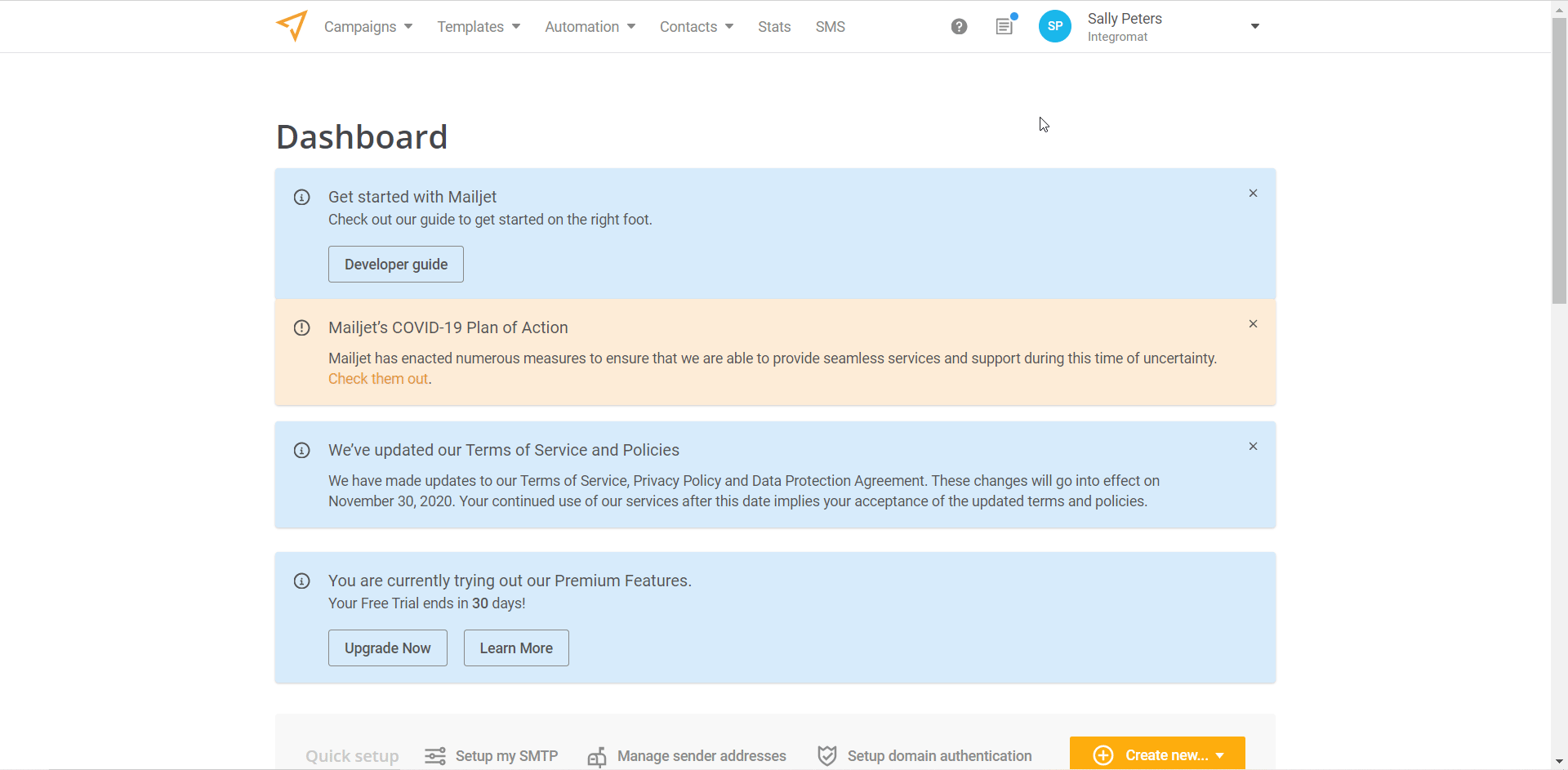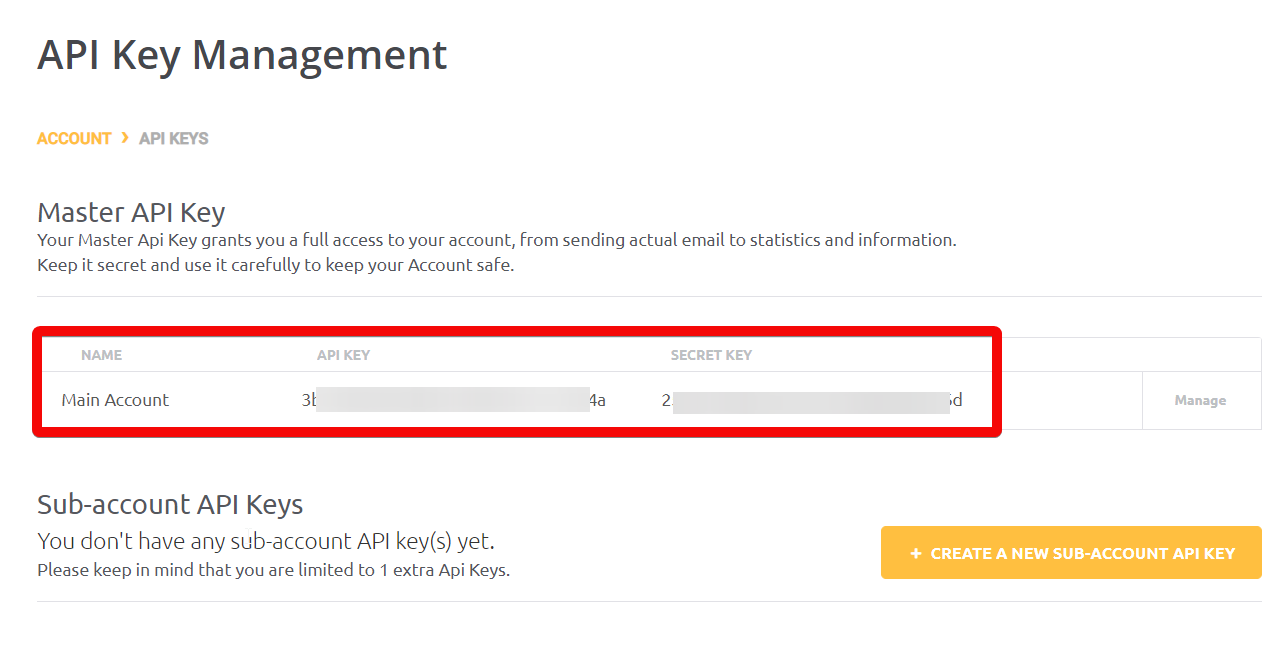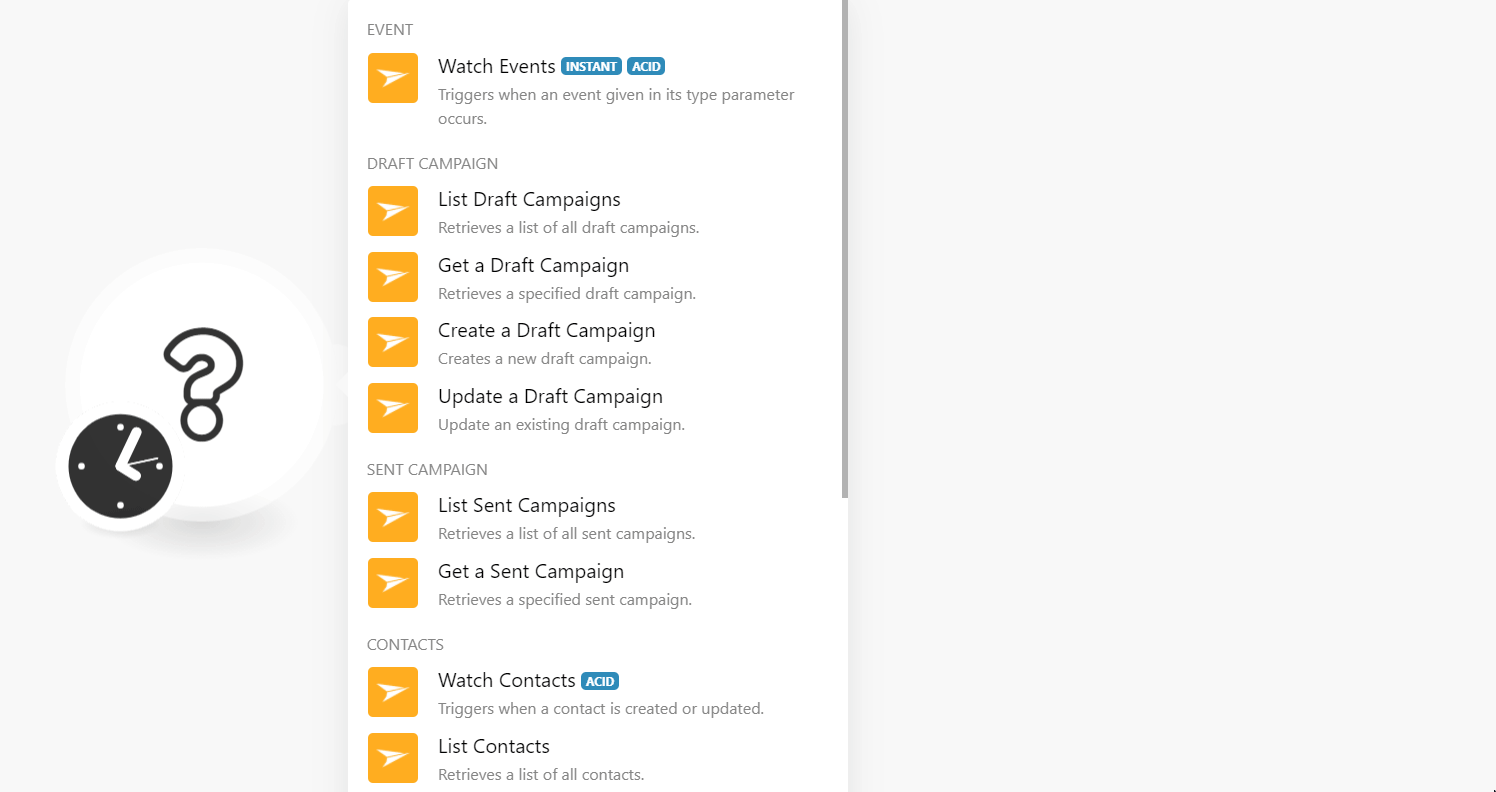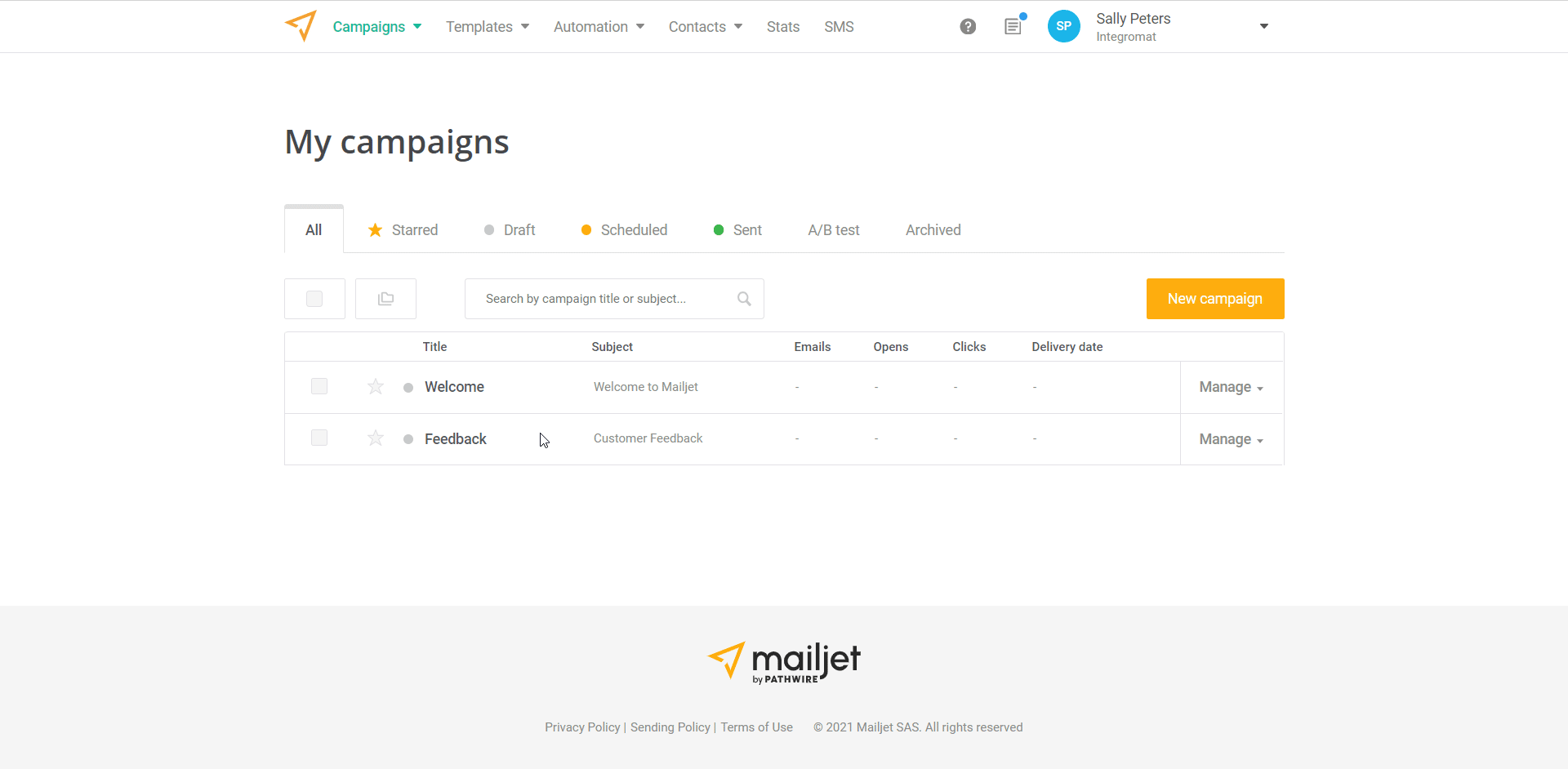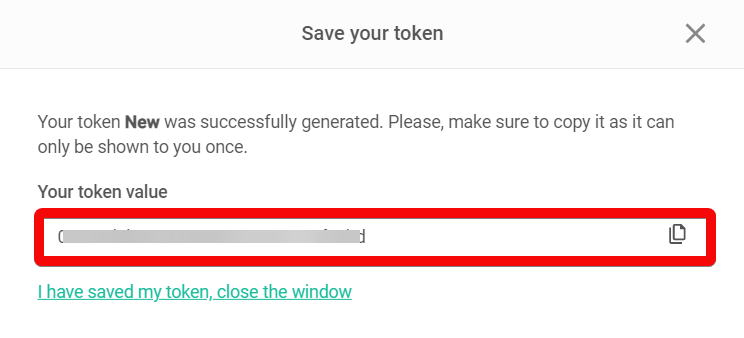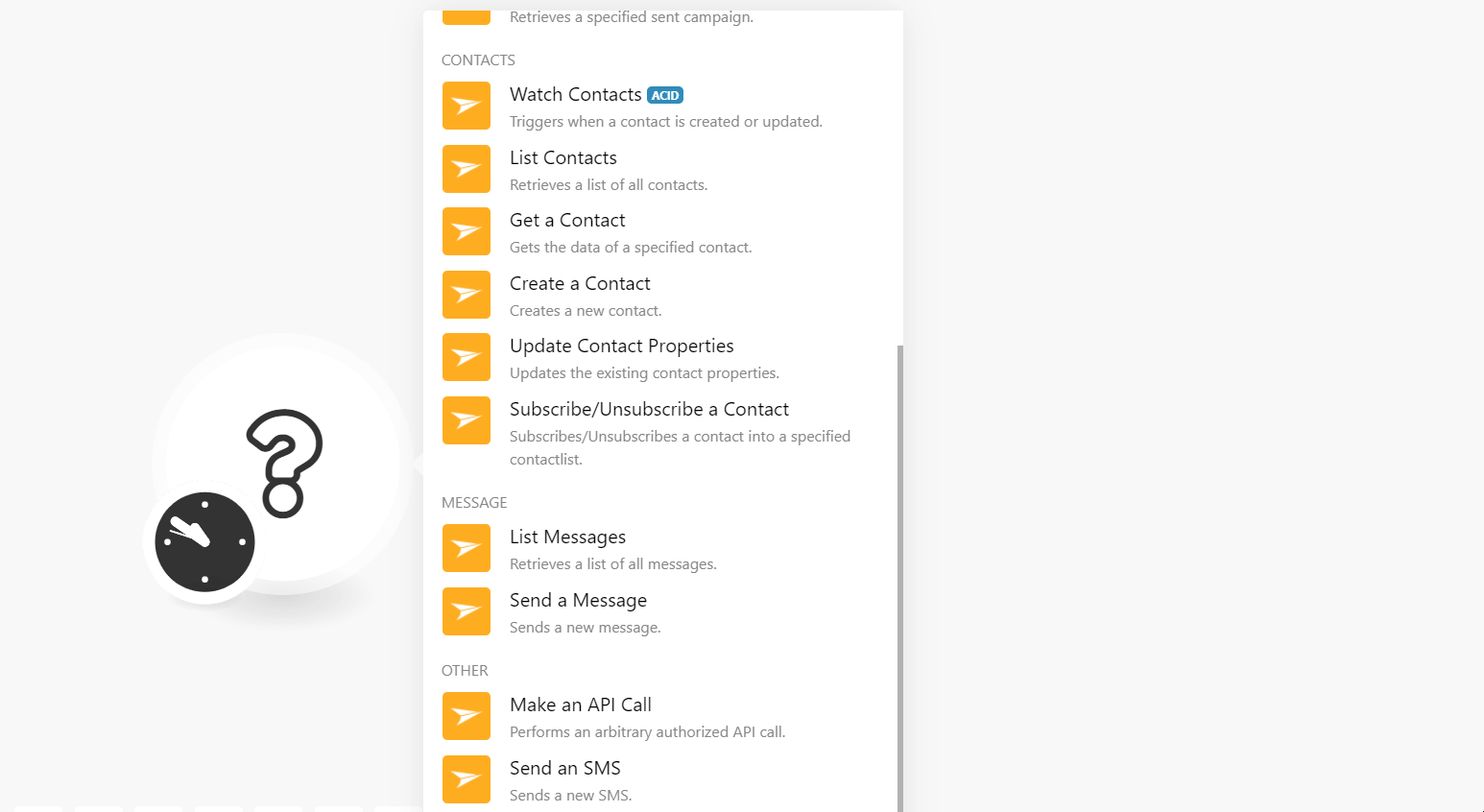| Active with remarks |
|---|
| This application needs additional settings. Please follow the documentation below to create your own connectionUnique, active service acces point to a network. There are different types of connections (API key, Oauth…). More. |
The Mailjet modulesThe module is an application or tool within the Boost.space system. The entire system is built on this concept of modularity. (module - Contacts) More allow you to monitor, create, update, send, retrieve, list, and delete the contacts, events, draft campaigns, messages, send SMS, and sent campaigns in your Mailjet account.
Prerequisites
-
A Mailjet account – can create a Mailjet account at https://www.mailjet.com/.
![[Note]](https://docs.boost.space/wp-content/themes/bsdocs/docs-parser/HTML/css/image/note.png) |
Note |
|---|---|
|
The moduleThe module is an application or tool within the Boost.space system. The entire system is built on this concept of modularity. (module - Contacts) More dialog fields that are displayed in bold (in the Boost.spaceCentralization and synchronization platform, where you can organize and manage your data. More IntegratorPart of the Boost.space system, where you can create your connections and automate your processes. More scenarioA specific connection between applications in which data can be transferred. Two types of scenarios: active/inactive. More, not in this documentation article) are mandatory! |
To connect your Mailjet account to Boost.space Integrator you need to obtain the API Key, and Secret Key from your Mailjet account and insert them in the Create a connection dialog in the Boost.space Integrator module.
-
Log in to your Mailjet account.
-
From the Dashboard, click Your Account Name > Account Settings > Master API Key & Sub API key management.
-
Copy the API Key and Secret Key values to a safe place.
-
Go to Boost.space Integrator and open the Mailjet module’s Create a connection dialog.
-
In the Connection name field, enter a name for the connection.
-
In the API Key and Secret Key fields, enter the details copied in step 3 respectively, and click Continue.
The connection has been established.
TriggersEvery scenario has a trigger, an event that starts your scenario. A scenario must have a trigger. There can only be one trigger for each scenario. When you create a new scenario, the first module you choose is your trigger for that scenario. Create a trigger by clicking on the empty module of a newly created scenario or moving the... when an event given in its type parameter occurs.
![[Note]](https://docs.boost.space/wp-content/themes/bsdocs/docs-parser/HTML/css/image/note.png) |
Note |
|---|---|
|
You do not have to add the webhooksA webhook is a way for an app to send real-time information to a specific URL in response to certain events or triggers. in the Mailjet as it is automatically done for you once you add and save an instant triggerEvery scenario has a trigger, an event that starts your scenario. A scenario must have a trigger. There can only be one trigger for each scenario. When you create a new scenario, the first module you choose is your trigger for that scenario. Create a trigger by clicking on the empty module of a newly created scenario or moving the... module to your scenario. |
|
WebhookA webhook is a way for an app to send real-time information to a specific URL in response to certain events or triggers. Name |
Enter a name for the webhook. |
|
Connection |
|
|
Events |
Select or map the events you want to watch. For example, |
Retrieves a list of all draft campaigns.
|
Connection |
|
|
Contact List ID |
Select or map the Contact List ID whose campaign you want to list. |
|
Delivered at |
Enter (map) the date to list the draft campaigns that were delivered on the specified date. |
|
Edit Mode |
Select or map the edit mode of the campaign: |
|
Select One of Boolean Parameters |
Select or map the parameter with which you want to mark the campaign:
|
|
StatusCreate statuses for each module separately to create an ideal environment for efficient and consistent work. More |
Select or map the status of the campaigns you want to list. |
|
Subject |
Select the subject line of the campaign you want to list. |
|
Template ID |
Select or map the Campaign Template ID to list the campaigns that match the specified ID. |
|
Limit |
Set a maximum number of draft campaigns Boost.space Integrator should return during one execution cycleA cycle is the operation and commit/rollback phases of scenario execution. A scenario may have one or more cycles (one is the default).. |
Retrieves a specified draft campaign.
|
Connection |
|
|
Campaign ID |
Select or map the Campaign ID whose details you want to retrieve. |
Creates a new draft campaign.
|
Connection |
|
|
Sender’s Email |
Select or map the email address from which the campaign will be sent. |
|
Sender’s Name |
Select or map the name that appears in the campaign email. |
|
Reply Email |
Enter (map) the email address to which the recipient can reply to the campaign email. |
|
Contact List ID |
Select or map the Contact List ID to whose contacts you want to send the campaign. |
|
Title |
Enter (map) the campaign name. |
|
Subject |
Enter (map) the subject line of the campaign email. |
|
Message Content Type |
Select or map the option to enter the message text for the campaign email:
|
|
HTM Body |
Enter (map) the email body message. |
|
Plain Text |
Enter (map) the email body message. |
Update an existing draft campaign.
|
Connection |
|
|
Campaign ID |
Select or map the Campaign ID whose draft campaign you want to update. |
|
Sender’s Email |
Select or map the email address from which the campaign will be sent. |
|
Sender’s Name |
Select or map the name that appears in the campaign email. |
|
Reply Email |
Enter (map) the email address to which the recipient can reply to the campaign email. |
|
Contact List ID |
Select or map the Contact List ID to whose contacts you want to send the campaign. |
|
Title |
Enter (map) the campaign name. |
|
Subject |
Enter (map) the subject line of the campaign email. |
|
Message Content Type |
Select or map the option to enter the message text for the campaign email:
|
|
HTM Body |
Enter (map) the email body message. |
|
Plain Text |
Enter (map) the email body message. |
Retrieves a list of all sent campaigns.
|
Connection |
|
|
Contact List ID |
Select or map the Contact List-ID whose sent campaigns you want to list. |
|
From |
Enter (map) the email address to list the sent campaigns from the specified email address. |
|
From Type |
Select or map the type of sent campaigns that you want to list:
|
|
Campaign Sent Since |
Enter (map) the date to list the campaigns that were sent on or after the specified date. See the list of supported date and time formats. |
|
Campaigns Sent Until |
Enter (map) the date to list the campaigns that were sent on or before the specified date. See the list of supported date and time formats. |
|
Is Deleted |
Select whether you want to list only the deleted sent campaigns. |
|
Is Newsletter Tool |
Select whether you want to list only the sent campaign created by the Newsletter tool. |
|
Is Starred |
Select whether you want to list only the sent campaigns that were marked as starred. |
|
Period |
Select or map the duration to list the sent campaign from the specified period. |
|
Sort |
Select or map the option to sort the campaigns. |
Retrieves a specified sent campaign.
|
Connection |
|
|
Campaign ID |
Select or map the Campaign ID whose details you want to retrieve. |
Triggers when a contact is created or updated.
|
Connection |
|
|
Watch Contacts |
Select or map the option to watch the contacts:
|
|
Campaign ID |
Select or map the Campaign ID you want to watch. |
|
Contact List ID |
Select or map the Contact List ID whose contacts you want to watch. |
|
Is Excluded from Campaigns |
Select whether you want to watch contacts that are added to excluding list for campaigns. |
|
Limit |
Set the maximum number of contacts Boost.space Integrator should return during one execution cycle. |
Retrieves a list of all contacts.
|
Connection |
|
|
Campaign ID |
Select or map the Campaign ID whose associated contacts you want to search. |
|
Contact List ID |
Select or map the Contact List ID whose contacts you want to search. |
|
Is Excluded from Campaigns |
Select whether you want to list the contacts that were added to teh excluding list for campaigns. |
|
Limit |
Set the maximum number of contacts Boost.space Integrator should return during one execution cycle. |
Gets the data of a specified contact.
Retrieves a list of all contacts.
|
Connection |
|
|
Contact ID |
Select or map the Contact ID whose details you want to retrieve. |
Creates a new contact.
|
Connection |
|
|
|
Enter (map) the email address of the contact. |
|
Name |
Enter (map) the contact’s name. |
|
Is Excluded from Campaigns |
Select whether the contact is added to the excluded list for campaigns. |
Updates the existing contact properties.
|
Connection |
|
|
|
Enter (map) the email address of the contact. |
|
Name |
Enter (map) the contact’s name. |
|
Is Excluded from Campaigns |
Select whether the contact is added to the excluded list for campaigns. |
Subscribes/Unsubscribes a contact into a specified contact list.
|
Connection |
|
|
Contact List ID |
Select or map the Contact List ID whose contact you want to subscribe to or unsubscribe. |
|
Contact’s Email |
Enter (map) the email address of the contact. |
|
Action |
Select or map the action you want to perform:
|
|
Name |
Enter (map) the contact’s name |
|
Properties |
Add the details of the properties of the contact. |
Retrieves a list of all messages.
|
Connection |
|
|
Campaign ID |
Select or map the Campaign ID whose messages you want to list. |
|
Contact ID |
Select or map the Contact ID whose messages you want to list. |
|
From |
Enter (map) the date to list the messages created on or after the specified date. |
|
To |
Enter (map) the date to list the messages created on or before the specified date. |
|
From Type |
Select the message sent type:
|
|
Message State |
Select or map the state of the message you want to list. For example, |
|
Message Status |
Select or map the status of the messages you want to list:
|
|
Limit |
Set the maximum number of messages Boost.space Integrator should return during one execution cycle. |
Sends a new message.
|
Connection |
|
|
Sender’s Email |
Select or map the Campaign ID whose messages you want to list. |
|
Sender’s Name |
Enter (map) the sender’s name. |
|
Recipients |
Add the recipients to whom you want to send the message: Recipient’s Email Enter (map) the recipient’s email address. Recipient’s Name Enter (map) the name of the recipient. |
|
CCs |
Add the email addresses of the contacts to whom you want to add in the CC field of the message: |
|
BCCs |
Add the email addresses of the contacts to whom you want to add in the BCC field of the message: |
|
Message Content Type |
Select or map the message content-type:
|
|
Subject |
Enter (map) the subject line of the message. |
|
Text Content |
Enter (map) the message text. |
|
Attachment |
Add the attachments to the message: File Name Enter (map) the file including the extension. For example, Data Enter (map) the file data. |
Performs an arbitrary authorized API call.
|
Connection |
||||
|
URL |
Enter a path relative to
|
|||
|
Method |
Select the HTTP method you want to use: GET to retrieve information for an entry. POST to create a new entry. PUT to update/replace an existing entry. PATCH to make a partial entry update. DELETE to delete an entry. |
|||
|
Headers |
Enter the desired request headers. You don’t have to add authorization headers; we already did that for you. |
|||
|
Query String |
Enter the request query string. |
|||
|
Body |
Enter the body content for your API call. |
The following API call returns all the draft campaigns from your Mailjet account:
URL:
/v3/REST/campaigndraft
Method:
GET
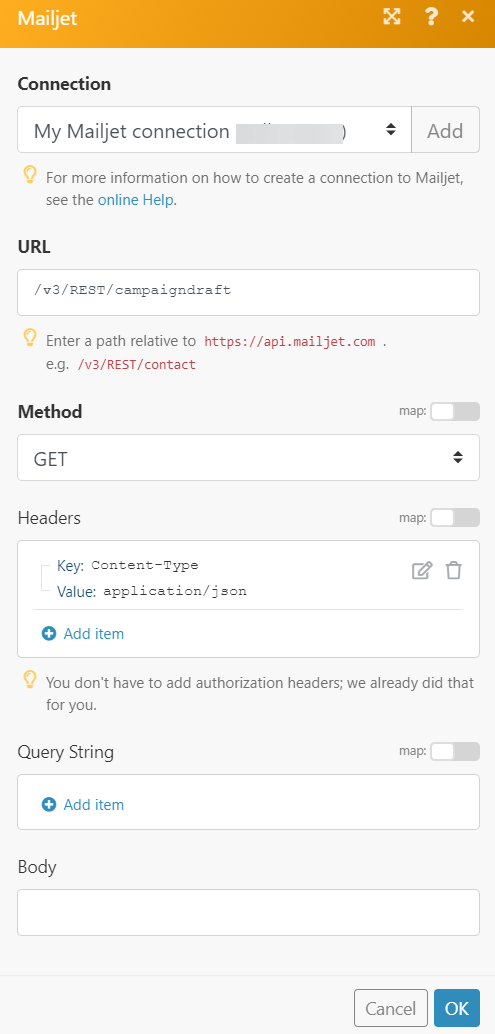
Matches of the search can be found in the module’s Output under BundleA bundle is a chunk of data and the basic unit for use with modules. A bundle consists of items, similar to how a bag may contain separate, individual items. More > Body > data.
In our example, 2 campaigns were returned:
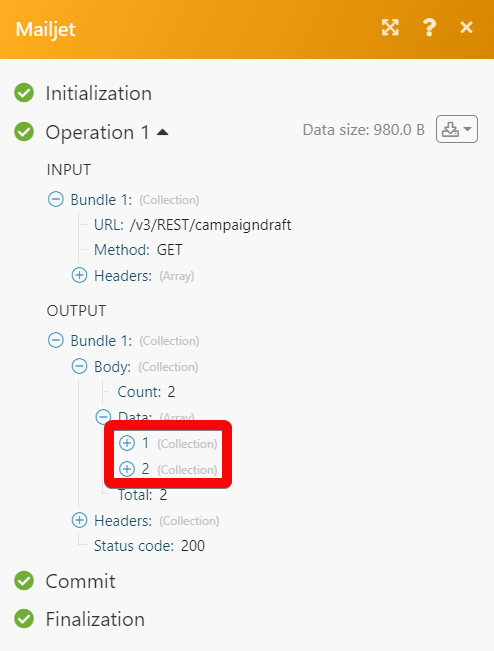
-
Log in to your Mailjet account, click SMS > Generate API TokenThe API token is a multi-digit code that allows a user to authenticate with cloud applications. More > Enter a name for the API > Generate.
-
Copy the API Token to your clipboard.
-
Go to Boost.space Integrator and open the Send an SMS module’s Create a connection dialog.
-
In the Connection name field, enter a name for the connection.
-
In the SMS API Token field, enter the token copied in step 2 and click Continue.
The connection has been established. You can now set up the scenario.
|
Connection |
|
|
From |
Enter (map) an alphanumeric Sender ID that can be customized for your convenience. For example, |
|
To |
Enter (map) the phone number of the recipient. The phone number must comply with the E.164 international telephone numbering standard. The phone number should start with a +, followed by the country code, and then followed by the phone number itself. For example, |
|
Text |
Enter (map) the content of the SMS message.For more information on the allowed length and message encoding, see the Concatenation & Encoding. |

